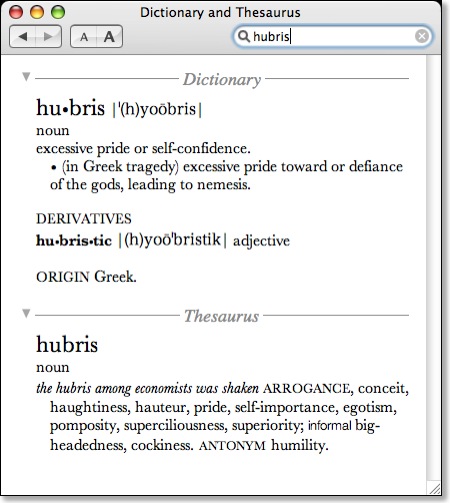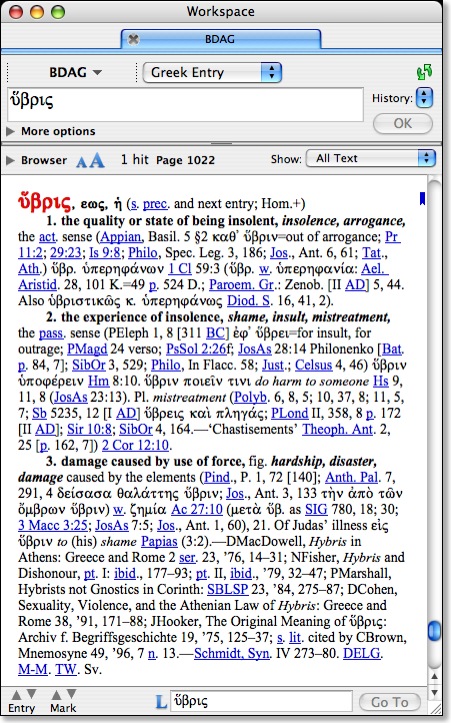Heads-Up: NLT Wide-Margins on the Cheap
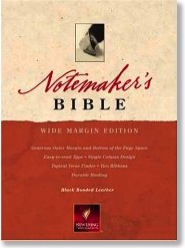
Personally, when it comes to Bibles, I'm a huge fan of generous wide-margins for taking notes. I would rather create my own notes through personal study than carry someone else's notes with me. Currently, I use a wide-margin NASB for personal study notes and wide-margin a HCSB for teaching notes. It's worth mentioning that a couple of weeks ago Crossway released a really nice edition of the ESV called the Journaling Bible which gives abundant space for notes (if you don't mind the tiny 7 pt print).
Sometime soon, I think I'll write a blog entry detailing the current offerings of wide-margin Bibles, organized by translation. In the meantime, I should mention to you fans of the New Living Translation (first edition) that Christian Book Distributors currently has a great deal on what I would assume to be close-out copies of The Notemaker's Bible: Wide-Margin Edition. You can even choose between black bonded leather ($14.99 instead of the regular $49.99), burgundy bonded leather (also $14.99 instead of $49.99) and the hardback at an incredible $7.99 (down from $24.99). At those prices, even if you merely wanted a copy of the NLT1 for reference, this would be a good choice. It also makes a great choice as a backup if you prefer the NLT1 over the NLT2.
If you've never seen Tyndale NLT Notemaker's Bible, I can tell you that it's really nice. In fact, I would dare say, it's one of the nicest wide-margin Bibles I've ever seen. One of my former students carried one regularly and so I've seen one firsthand. I wish I had a page spread to show you here, but I cannot find one online. However, the Notemaker's Bible has a generous 1 1/2" margin on the sides for notes and an incredible two inches of lined space at the bottom for journaling. The text is in a single-column format (which I prefer for a wide-margin Bible) and I don't know the exact type-size, but it's definitely larger than your average reference Bible and easy on the eyes. The pages are also thick enough that reasonable note-taking shouldn't bleed through. Words of Christ are in black (which I prefer). If you prefer leather over hardback, Tyndale has really improved the quality of their leather--even bonded leather--in recent years, and the Notemaker's Bible is no exception. This is a quality-made Bible that will last a long time.
Currently, there are no wide-margin editions available for the second edition of the NLT.
And before you ask, no--neither Tyndale, nor CBD sends me any royalties! I just thought this was a really good deal and figured I'd share it.
A Lame Dance (1 Kings 18:26)
In reading the showdown between Elijah and the priests of Baal today, I noticed a rather unusual expression in the Holman Christian Standard Bible's rendering of 1Kings 18:26--
"So they took the bull that he gave them, prepared it, and called on the name of Baal from morning until noon, saying, 'Baal, answer us!' But there was no sound; no one answered. Then they did their lame dance around the altar they had made" [emphasis added].
"Lame dance" is what caught my eye. I am used to reading that they "leaped" around the altar. Below is a table with a number of translations represented. Originally, I was going to include the Hebrew from the BHS, but I am having trouble getting it to display correctly in the table. Nevertheless, the key phrase of importance is וַֽיְפַסְּח֔וּ עַל־הַמִּזְבֵּ֖חַ אֲשֶׁ֥ר עָשָֽׂה׃ and I have emphasized that in bold in the table below:
| 1 KINGS 18:26 | |||
|---|---|---|---|
KJV |
RSV |
NRSV |
NASB95 |
| And they took the bullock which was given them, and they dressed it, and called on the name of Baal from morning even until noon, saying, O Baal, hear us. But there was no voice, nor any that answered. And they leaped upon the altar which was made. | And they took the bull which was given them, and they prepared it, and called on the name of Ba'al from morning until noon, saying, "O Ba'al, answer us!" But there was no voice, and no one answered. And they limped about the altar which they had made. | So they took the bull that was given them, prepared it, and called on the name of Baal from morning until noon, crying, “O Baal, answer us!” But there was no voice, and no answer. They limped about the altar that they had made. | Then they took the ox which was given them and they prepared it and called on the name of Baal from morning until noon saying, “O Baal, answer us.” But there was no voice and no one answered. And they leaped about the altar which they made. |
HCSB |
ESV |
NLT2 |
TNIV |
| So they took the bull that he gave them, prepared it, and called on the name of Baal from morning until noon, saying, “Baal, answer us!” But there was no sound; no one answered. Then they did their lame dance around the altar they had made. | And they took the bull that was given them, and they prepared it and called upon the name of Baal from morning until noon, saying, “O Baal, answer us!” But there was no voice, and no one answered. And they limped around the altar that they had made. | So they prepared one of the bulls and placed it on the altar. Then they called on the name of Baal from morning until noontime, shouting, “O Baal, answer us!” But there was no reply of any kind. Then they danced, hobbling around the altar they had made. | So they took the bull given them and prepared it. ¶ Then they called on the name of Baal from morning till noon. “Baal, answer us!” they shouted. But there was no response; no one answered. And they danced around the altar they had made. |
What we see here is that the KJV and NASB95 translate פסח/pasach as "leap" while the RSV/NRSV/ESV tradition uses "limped," NIV/TNIV uses "danced," and the HCSB and NLT seem to combine the concepts of dancing and limping (or "hobbling" in the NLT).
According to the Koehler-Baumgartner Hebrew lexicon, פסח/pasach, when used in the piel form as it is in this verse, conveys the meaning, "to limp about in a cultic ceremony, perform a hobbling dance." While the RSV/NRSV/ESV tradition seems to improve upon the rendering in the KJV and NASB, only the HCSB and NLT incorporate both connotations of dancing and limping/hobbling. I'm not exactly sure what this shuffling dance was like, but it was obviously not ballet. Incidentally, the first edition of the NLT (1996) renders פסח/pasach as "danced wildly," perhaps borrowing from the NEB/REB, but this phrase does not quite capture the meaning of the word either.
I should note, too that the writer of 1 Kings is making a play on words regarding the actions of the priests of Baal. The same word is used in the Hebrew in v. 21 when Elijah asks the Israelites how long they will go on pasach-ing between two opinions. Of the English translations mentioned above, only the RSV/NRSV/ESV and the NLT make the connection of this pun in English, something very difficult to catch outside the Hebrew.
Regardless, except for the HCSB and NLT, most translations do not accurately convey both the dancing and limping elements of פסח/pasach. Perhaps this is a good example as to why sometimes a literal word-for-word translation method is less than effective in conveying the meaning of the original text.
And while the rendering "lame dance" in the HCSB caught my attention, I have to admit that I misread the verse. Lame can mean "unable to walk" or it can mean "ineffective or weak."
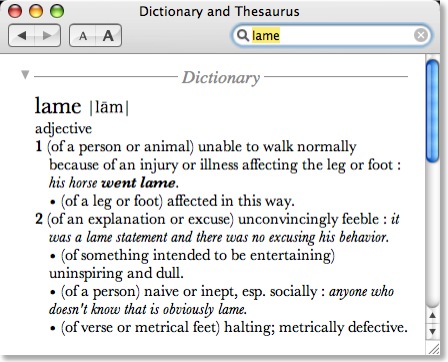
When I read, "They did their lame dance..." I mentally heard the voice of one of the high school students I used to teach saying, "That's so lame" about something he thought was stupid. Now while we might agree that the dance performed by the priests of Baal was ineffective and stupid, and perhaps we might have used the same sentiment as the high school student had we been there, this idea of lame is not what the writer of 1 Kings had in mind. Therefore, I have to assert that the HCSB, while attempting to convey the full meaning of פסח/pasach, falls a bit short because the reading might easily be interpreted as contemporary slang. This reminds me of the decision on the part of the CEV translators to avoid using the word "awesome" for God because of how it is so often misappropriated and overused among teenagers.
In the end, I'll have to conclude that the NLT's rendering is the most accurate: "Then they danced, hobbling around the altar they had made." I still don't know exactly what this dance looked like but I tried to demonstrate my best guess to Kathy. I'm sure my presentation was as comical to her as the priests of Baal's dance was to Elijah. And she agreed, it was lame...
A Time When Israel and Lebanon Were Allies

Above: Modern-day Israel with Lebanon to the north.
Currently, Israel and Lebanon are at war, but there was a time in ancient history that the region had strong alliances.
Consider the following, mostly from the 10th Century BC:
1. Multi-generational alliances: 1 Sam 5:11; 1 Kings 5:1.
2. Worker-exchange programs: 1 Kings 5:13-14; 7:14.
3. Free trade of food and resources: 1 Kings 5:10-11.
4. Contributions to Israel's religious life: 1 Kings 5:6-18
5. Contributions to Lebanese building projects: 1 Kings 9:19
6. Political marriage unions: 1 Kings 16:31 (although this would not prove positive for Israel)
7. Resources for Jerusalem's reconstruction: Ezra 3:7 (5th Century BC).
Below: Trade routes in Solomon’s time, showing principal imports and their sources.
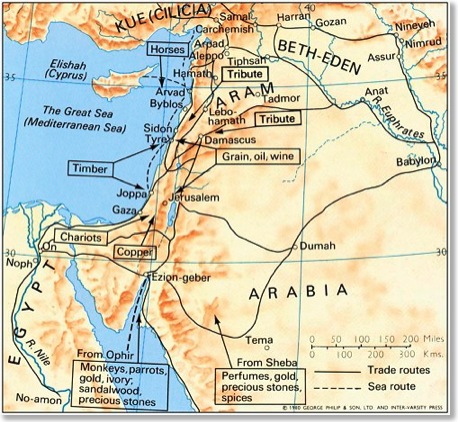
So, what the heck happened?
Sympathy for the Devil? ABC Family's "The Fallen"
(Genesis 6:4, HCSB)

Out of curiosity, I watched a repeat of the premier of The Fallen tonight on the ABC Family Channel. Knowing that they were basing the show's mythology off the rather obscure verses at the beginning of Genesis 6, I admit I was mildly intrigued. Here, with multiple typos left as they are other than my note of them (= sic), is ABC Family's synopsis from the website for The Fallen:
All Aaron ever wanted was a normal life. Newly adopted by Lori and Tom Corbett, Aaron believes that he finally has a chance to be like everyone else. Hes [sic] good at school. Hes [sic] on the wrestling team, and Vilma, the preiitest girl in school, knows hes [sic] alive. But on his 18th birthday everything changes.
Suddenly, Aaron has unusual powers and a strange dream haunts him. A homeless man name [sic] Ezekiel, who claims to be a fallen angel, tells Aaron that he is a Nephilim, or half-angel/half-human. Zeke warns Aaron that the Powers, an army of killer angels, are are coming to destroy him. If Zeke is right, then Aaron has been swept into a centuries-old battle between the Powers and the Fallen, a group of angels banished from heaven. Aaron shakes off Zekes [sic] ravings but startling events lead him to think that maybe Zeke could be right. There is a mysterious man in a black [sic; word is missing, possibly "coat"?] following him. His newfound abilities seem to be getting stronger, and he sees signs in the most unlikely places. When Aaron comes face to face with his fate, he can no longer deny the truth.
Caught in a celestial war waged on Earth and haunted by an ancient prophesy [sic], Aaron is forced to make a difficult choice. His chances of being normal are gone, but is he The One?
There you have it, Frank Peretti meets Highlander. The two-hour premier (there are plans for six more hours in 2007) was fairly light popcorn stuff. It felt like a fantasy version of a coming-of-age story on an After-School Special of years gone by. I guess that's to be expected since the movie was based on the young adult novel of the same name by Tom Sniegoski. I have no idea how close the movie was to Sniegoski's original story having not read it, but I wasn't overly impressed with the cinematic interpretation.
The story itself felt very contrived and predictable. When Aaron's dog gets hit by a car right before a commercial break, it was pretty evident that this would be a reason to highlight Aaron's developing "angel powers." The high school drama is fairly typical. Aaron is the new guy at school and suddenly the most popular girl takes notice of him. He clashes with the jocks on the wrestling team of which he is a member--perhaps as an allusion to Jacob wrestling the angel in Gen 32?


The mythology (I would really hate to call it theology) is one of the more bizarre aspects of The Fallen. Satan is never directly referenced except as "the powerful angel who led a rebellion in heaven." The story takes an extreme mythological interpretation of Genesis 6:1-4, to say that fallen angels have procreated with humans resulting in half angels/half human hybrids called the Nephilim. A hit squad of angels called the Powers has been commissioned by God to eliminate any of these half-breeds they can find. If the Angels have to torture and even kill normal humans in order to find the Nephilim, well, these are merely collateral damage. The battle near the end with what looked like flaming light sabres was quite laughable.
Thus you have a story that makes the angelic hosts look like the bad guys and sympathy is given to the fallen angels and especially their half human offspring who are killed in spite of their pleas for mercy. To make things even more bizarre, it seems there is an ancient prophecy (not a biblical prophecy, mind you) that says a Nephilim will arise who will stand in the gap between God and the fallen angels offering them redemption. Of course, Aaron (appropriate named after Moses' brother, the first high priest of Israel) turns out to be this prophesied Nephilim, also known as--shades of Highlander and the Matrix trilogy--The One.
Skerritt's character also has to deliver a politically correct line equating the God of the Bible with Allah, Shiva, and any other concept of God. Never mind the irreconcilable differences between these theologies. If there was any question as to whether the writers have a respectful view toward the Judeo-Christian tradition, this clearly demonstrates that they do not.
The Bible, of course, makes no mention of redemption regarding fallen angels. Perhaps their sin was even more egregious because of their intimate knowledge--even greater than ours--of the one true God. But that also makes us ask whether a mythological interpretation of Genesis 6:1-4 is the best one. Although the interpretation regarding relations between angels and humans is very old and has had many notable proponents, it seems to be contrary to other statements in the Bible including Jesus' remarks about angels: "For when they rise from the dead, they neither marry nor are given in marriage but are like angels in heaven" (Mark 12:25, HCSB). Plus the idea of angelic/human coupling seems a bit repugnant to me under any condition.
Another line of interpretation would identify the sons of God with "the godly line of Cain" while the daughters of men are said to be "the sinful line of Cain." This seems unsatisfying as well. A better solution is offered by Walter Kaiser in Hard Sayings of the Bible:
The preferable interpretation of this passage is the sociologically mixed view. "Sons of God" is an early, but typical, reference to the titularies for kings, nobles and aristocrats in the ancient Near Eastern setting. These power-hungry despots not only lusted after power but also were powerfully driven to become "men of a name" (or "men of renown"-- Gen 6:4).
In their thirst for recognition and reputation, they despotically usurped control of the states they governed as if they were accountable to no one but themselves. Thus they perverted the whole concept of the state and the provision that God had made for some immediate amelioration of earth’s injustices and inequities (Gen 6:5-6; see also Gen 10:8-12). They also became polygamous, taking and marrying "any of [the women] they chose" (Gen 6:2).
What evidence can be produced for the correctness of this view? There are five lines of evidence. (1) The ancient Aramaic Targums render "sons of God" as "sons of nobles" (Targums of Onkelos), and the Greek translation of Symmachus reads "the sons of the kings or lords." (2) The word gods (Hebrew elōhîm) is used in Scripture for men who served as magistrates or judges ("Then his master must take him before the judges [elōhîm]," Ex 21:6; see also Ex 22:8; Ps 82:1, 6). (3) Structurally, the account of the Cainite Lamech (Gen 4:19–24) and that of the "sons of God" in Genesis 6:1-4 are very much alike. In each there is the taking of wives, the bearing of children and the dynastic exploits. The former passage ends with a boast of judgment by Lamech, and the other ends with God’s decree of judgment. Lamech practiced bigamy (Gen 4:19), and he enforced his policies by using tyranny. The portraits are parallel and depict states of tyranny, corruption and polygamy. (4) Near Eastern discoveries have validated the pagan use of all sorts of gods' and goddesses' names in order to give more clout and prestige to the governments of Egypt and Mesopotamia--hence the title "sons of God."
The fifth and final line of evidence concerns the nep̄lîm/gibbôrîm of Genesis 6:4. The word nep̄lîm occurs only here and in Numbers 13:33, where it refers to the Anakim, who were people of great stature. The root meaning of the word nep̄lîm is "to fall." However in Genesis 6:4 the nep̄lîm are associated with the term gibbôrîm. The word gibbôrîm comes from gibbôrîm, meaning "a mighty man of valor, strength, wealth or power." Nimrod, in Genesis 10:8, was such a gibbôrîm. He also was clearly a king in the land of Shinar. Hence the meaning of nep̄lîm/gibbôrîm is not “giants,” but something more like "princes," "aristocrats" or "great men."
Genesis 6:1–4, therefore, is best understood as depicting ambitious, despotic and autocratic rulers seizing both women and power in an attempt to gain all the authority and notoriety they could from those within their reach. Their progeny were, not surprisingly, adversely affected, and so it was that God was grieved over the increased wickedness on planet Earth. Every inclination of the hearts and thoughts of humanity was evil. Thus the flood had to come to judge humankind for the perversion of authority, the state, justice and human sexuality.
This seems to be the most sensible interpretation of Gen 6:1-4 to me, but your mileage may vary.
As an aside, I must ask what happened to the purpose of the ABC Family channel? ABC bought the network from Pat Robertson's media company when it was originally known as the CBN Family Channel. I'm no fan of Robertson or CBN, but I'll admit there was some occasional good programming when it was under CBN control. Much of The Fallen seemed quite unsuitable for primetime family viewing as it was rated TV-14 for language and violence. The language, although tamer than what you would find in a rated-R movie, seemed unnecessary and even inappropriate at times. Again, it makes me question exactly how "family"-oriented ABC Family actually is.
Monster Agendas
First, over at the Better Bibles Blog, Peter Kirk has accused the TNIV translators of having a complementarian agenda. Yes, you heard that right--a complementarian agenda. Usually, the TNIV translators are accused of having an egalitarian agenda, so Peter's post is highly ironic. I personally don't think it has either agenda, although complementarians and egalitarians are both represented on the thoroughly evangelical translation committee.
Second, my old friend (and church planter) Bill Craig has written a very moving blog entry entitled "Monster House." Here he describes the living conditions and encounters with neighbors that he and his wife Jill experienced during their first church plant out of seminary. Here's an excerpt, but be sure to read the whole entry:
The upstairs shower was about to drop through the ceiling any minute. You could see the center part of the ceiling dropping with the outline of the shower in the upstairs bathroom. My biggest nightmare was that a large, naked, angry, tattooed, drinking and swearing mother would drop through while I was eating my breakfast and doing my devotionals and I’d lose my appetite for the rest of my life. But maybe it was a selfish hope, because maybe then we could have the little children and show them the love of Christ they didn’t know.
The Parallel Apocrypha
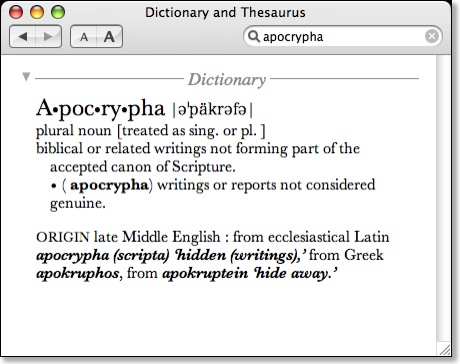
When Martin Luther translated the Bible into his native German, he included the disputed books--commonly known as the Apocrypha--in a section between the Old and New Testaments. In defense of doing so, he added this comment: "Apocrypha--that is, books which are not regarded as equal to the holy Scriputres, and yet are profitable and good to read." Add to that Augustine's sentiment (as quoted in the preface to the KJV) that "variety of Translations is profitable for the finding out of the sense of the Scriptures," and you have The Parallel Apocrypha from Oxford Press.
Although published in 1997, I did not stumble across The Parallel Apocrypha until earlier this year. The book is edited by John Kohlenberger III, who at some point seems to have made parallel editions of just about every combination of the Scriptures imaginable. This work is considered parallel because over a two-page spread (for most texts), the Apocrypha is presented in Rahlfs' Septuagint Greek beside four Catholic translations (Douay, Knox, New American Bible and New Jerusalem Bible) and three Protestant translations (King James Version, Today's English Version, New Revised Standard Version).
Until I obtained this volume, I didn't realize that all traditions do not hold identical lists of what is considered apocryphal (or deutercanonical in Catholic and Orthodox traditions). For instance, Roman Catholic, Greek and Slavonic Bibles all include Tobit, Judith, Greek additions to Esther, Wisdom of Solomon, Ecclesiasticus, Baruch, Letter of Jeremiah, Greek additions to Daniel (Prayer of Azariah and the Song of the Three Jews/Bel and the Dragon), and 1 & 2 Maccabees. But 1 Esdras, Prayer of Manasseh, Psalm 151, and 3 Maccabees are only found in the Greek and Slavonic Bible, but are not in the Catholic Canon. 2 Esdras only appears in the Slavonic Bible and 4 Maccabees appears only as an appendix to the Greek Bible.
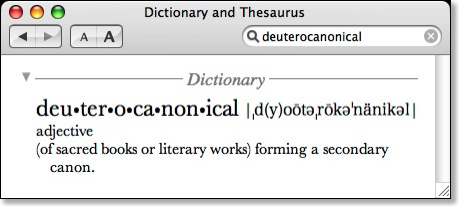
Interestingly, the only English translation included in The Parallel Apocrypha to cover all of these books is the NRSV, thus (I assume) making it the most ecumenical translation of the Bible in existence. The only book in the list not to be represented in the Greek is 2 Esdras because no complete Greek manuscript for it exists. Therefore, 2 Esdras is represented with Weber's edition of the Latin Vulgate (alongside only the KJV, TEV, and NRSV).
A very useful bonus to the texts themselves are a number of introductory essays. Judith Kovacs writes on "The Contents and Character of the Apocryphal/Deuterocanonical Books" which provides an excellent introduction to the history, content and literary style of these books. Kohlenberger himself contributes an essay regarding the texts and translations found in The Parallel Apocrypha. If you've ever read any histories of the Bible in English, you may very well be interested in this short history of the Apocrypha in English. Finally, essays are included from a number of different faith traditions: Jewish (Sarah J. Tanzer), Orthodox (Demetrios J. Constanelos), Catholic (John J. Collins), Anglican/Episcopalian (Mary Chilton Callaway), Protestant (Walter J. Harrelson) and Evangelical (D. A. Carson). The addition of these essays helps to take the Apocrypha beyond its status as merely an historical religious document and places it squarely into a faith context.
The book itself is almost 1200 pages long, but the publishers used thin "Bible" paper, so The Parallel Apocrypha is only about one-inch thick. One translation that I wish Kohlenberger included is the Revised English Bible. I would have preferred the REB over the Knox Translation, however, I understand that the Knox Translation is significant because it is a more dynamic translation of the Latin Vulgate and sits well beside the more formal-equivalent Douay version, also from the Vulgate. And I suppose that there was a concerted effort on the part of the editor to include one more Catholic translation (four) over Protestant translations (three included) since these books take a more significant status in the Catholic tradition. Of course, if one considers that there are also renderings of the Apocrypha in the Revised Standard Version and the New Living Translation, it would seem that Protestants often pay more attention to these books than Catholics do themselves. Currently, there is no translation of the Bible in English from the Greek Orthodox tradition, but from what I understand, one is in the works.
In spite of all the Protestant translations in existence, I believe that generally, Protestants are the most guilty for neglecting the Apocrypha. Regarding the Apocrypha, I am in agreement with those who have gone before me in my own faith tradition that these books are not considered to be inspired Scripture. Even the writer of 2 Maccabees admitted as much when he wrote, "...So I will here end my story. If it is well told and to the point, that is what I myself desired; if it is poorly done and mediocre, that was the best I could do" (2 Mac 15:37-38, NRSV). Such sentiment hardly seems up to the level of being "God-breathed."
However, I would agree with Luther that these books are profitable and good to be read for two reasons. First, they are written by believers in the God of the Bible. Just as one might walk into a Christian bookstore and buy devotional literature or even historical fiction, the Apocrypha can be read in the same way (plus, I've always suggested the reading of Tobit to discover where Frank Peretti borrowed his best stuff). Further, and more importantly, the historical books of the Apocrypha, especially 1 & 2 Maccabees fill in the 400 year historical gap between the Old and New Testaments. If it's true that the New Testament cannot be understood apart from the Old Testament, it might be equally true that the culture and the historical situation of Jesus' day cannot be properly understood without the information derived from reading the Apocrypha.
What If You Could Live Forever?
The Fountain, scheduled for an October 2006 release and staring Hugh Jackman and Rachel Weisz, looks genuinely interesting.
The Qoheleth complained in Ecclesiastes 3:20 that "All are going to the same place; all come from dust, and all return to dust" (HCSB). From what I can gather, The Fountain is a story told in three acts about the desire to forestall or perhaps completely prevent our eventual expiration through death. The story takes place in the 1500's, present day, and the year 2500. If I understand correctly, while Jackman and Weisz play the main protagonists in all three settings, they are not the same characters.

Trivia: Jackman had to shave off all upper body hair for the sequences that take place in 2500 because I guess we'll all be hairless in the future.
If you want a better quality video clip of the trailer (or more variety), go to the Quicktime site for The Fountain.
Quote for the Day #8
"One reason [atheist, Albert] Camus's writing is so powerful is that he refuses to try to explain the suffering of the innocent. Instead his response is to be morally enraged and to try and do something to stop it. I think this is the response God wants from people" (p. 16).
"As a generalization, it seems safe to say that Americans prefer Wal-Mart to libraries, Big Macs to big ideas, and TV to education. This worries me, and I find that for whatever reason, many atheists, like Greg share my concerns" (p. 18).
Source: Jones, Preston, and Greg Graffin. Is Belief in God Good, Bad Or Irrelevant? A Professor and a Punk Rocker Discuss Science, Religion, Naturalism and Christianity. Downers Grove, Illinois: InterVarsity Press, 2006.
Note: Jones is an assistant professor of history at John Brown University in Siloam Springs, Arkansas. Graffin has a Ph.D in evolutionary biology from Cornell and just happens to be lead singer and songwriter for the band, Bad Religion.
The Family Side of Johnny Cash
Last year, when I reviewed Walk the Line, Darcie (Cash) Johnson emailed me, reminding me that she was Johnny's cousin (FYI: Darcie and my wife Kathy were fast friends in high school and roommates their first year of college). To be honest, I didn't remember the Cash-family connection. I knew that Darcie's last name was Cash before she married Jeffrey Johnson, but I don't think I realized her relation to the late singer.
Originally, I planned to post this story last year, but at her initial time of writing, Darcie couldn't find the picture of her and Johnny Cash. She sent it a few weeks later, but it got set aside in the busyness of my thoughts. Andrew's review of American V reminded today me.
Anyway, the story she related in her message rings so true from everything I've ever heard about Johnny Cash. I'm sure there are many such stories about him, but I believe Darcie's account perfectly describes Cash's love of family over fame and fortune. This event took place approximately 30 years ago when Darcie was seven-years-old.
Darcie writes:

It was my mom and dad, my maternal grandmother (who became a country music fan that day), and me. He hugged and kissed us three women and talked over old times as children in Arkansas with my father for probably a half hour. The stage manager kept coming back and saying "Johnny, come on. You're on now" and Johnny would wave his hand and say "a few more minutes."
So June Carter and the Carter sisters were his opening act so they would sing another song. Then the guy would come back and say it again, Johnny would wave his hand again and June would sing another song. This happened 3 or four times before Johnny kissed us all and went on and June could rest her pipes.
Goodbye, Johnny
[RICK'S NOTE: At the risk of overly-commercializing Andrew's review of Johhny Cash's music, I thought it would be helpful to provide direction to those who would want to obtain the music discussed here. All text links will direct you to the iTunes Music Store and if you prefer physical CDs, obviously all graphical links go to Amazon.com.]
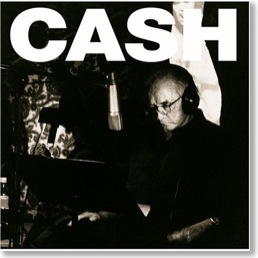
Even if it was a Nine Inch Nails cover, his last single "Hurt" from American IV: The Man Comes Around would have been a beautiful final statement. With all that he accomplished in life, all he had seen and done, "Every one I know goes away in the end." It is the loss of family and friends that mark his days. The music video is probably one of the most moving ever created, cutting back and forth between pictures of Johnny Cash in all the stages of his life and video of him as an old man among his memories. It would have been a perfect ending to Cash’s career.
Would have. Rick Rubin, Cash's producer, should have waited a lot longer to release American V: A Hundred Highways--or maybe not at all.
It's not that it is bad. Cash really seemed to relish stripping his style bare, and that comes through here. But none of the songs really have the punch of "Hurt," yet the whole album is an extension of that one song. Whether doing covers of originals, directly or indirectly, the theme of every song becomes death. Several seem to have been selected with his wife, June Carter Cash in mind (she passed away four months before he did). As a statement and as a historical document--Cash sings several traditional tunes--it has real value. As an album, though, it’s really hard to listen to.
Rubin states in the liner notes that eventually he will release a boxed set of Cash’s material called Unearthed. In the last months of his life, Cash was recording as much as he was physically able to, singing songs that had been passed down to him or had been well-known in his childhood. If Rubin had been wise, he would have added this last album to the set, instead of releasing it separately. American V doesn’t tarnish Cash’s career at all; it just doesn’t provide the closure like it should--like "Hurt" does.
After Elvis Presley, Johnny Cash's material seems to be on every recording label possible. There must be dozens of "greatest hits" CDs alone. The problem is that, as with Presley, you have to dig through a lot of Cash’s recordings to get to the real jewels, and his albums haven't all been reissued. Here are some recommendations if you are starting out, wanting to cover your bases or if you are just diving in:
For his earliest work, get The Sun Years which has all his important singles and several B-sides he made for Sun Records.
Cash jumped ship to Columbia Records (now Sony Music) when he couldn’t make the music he wanted. The absolute necessity from this time is Johnny Cash at Folsom Prison. It covers several different types, shows Cash at his best, and is arguably the greatest live album ever. Pick up the "American Milestones" edition if possible, because it has the complete (and unedited--be warned) concert. Johnny Cash at San Quentin is also supposed to be quite good, though not quite in the same category.
For Cash’s religious side, seek out Hymns by Johnny Cash, the "American Milestones" edition. Shortly after he died, Rubin released My Mother’s Hymnbook, a collection of hymns done in Cash’s later style. It hasn’t received near the attention that this last album has received—I’ve mostly seen it in Christian bookstores—but worth a listen.
From his American Recordings era, the essential is American Recordings. Just strumming a guitar, Cash takes a bunch of songs from wildly different writers (Nick Lowe, Henry Rollins and Leonard Cohen, to name a few) and somehow melds them into a cohesive, beautiful whole. His follow-up, Unchained, finds Cash going back to his rock and country roots, with great success. The third and fourth American albums, while well-produced, are hit-and miss.
Until we are able to hear Unearthed, the gold standard for "previously unreleased material" seems to be Personal File, a collection of songs Cash recorded in the 70s and early 80s but for unknown reasons never released. Again, it's just him and his guitar, but that was what Johnny Cash was all about.
Andrew Wells can be reached at arwell012002@yahoo.com.
Eve Names the Kiss
by Gwen Hart
He sat upon the garden wall.
She had her fingers on his knees.
The smallest leaves began to fall.
A subtle difference in the breeze.
Prompted the tiger and the hare
to linger there. Even the snake
slithered closer so to hear
what sound she'd make. They'd heard him speak
a thousand times, define the world
from bumblebee to elephant.
His syllables were muscled, bold.
But she, they felt, was different.
The future trembled on her lips.
Her mouth was like an apple split,
two halves as supple as her hips.
And when she said the word, he bit.
Source: First Things, August/September 2006, No. 165, p. 35.
The Revised English Bible (Top Ten Bible Versions #6)

When I wrote my review of the New American Standard Bible, I noted that it would be my desert island Bible. Well, the REB would be a strong contender for that position, too, but for different reasons. When the REB was first published in 1989, I was a junior in college majoring in English. Having been exposed to so much good literature by that point, I immediately noticed the quality of style for which the REB would become recognized. In my opinion--and I am not alone in this sentiment--the Revised English Bible has the best overall literary quality of any modern English translation--the best since the King James Version. When I was working on my M.Div in the early nineties, one of the Old Testament professors at the Southern Baptist Theological Seminary required the REB as his main text in his OT intro classes. He believed that the REB best reflected the Hebrew text in modern English, especially regarding the poetic sections.
There are a handful of biblical passages I like to refer to when trying to get a feel for a particular translation. Three are reproduced below as they read in the REB:
Proverbs 1:8-19 |
Matthew 6:1-8 |
Romans 7:14-25 |
Attend, my son, to your father's instruction My son, if sinners entice you, do not yield. |
'Be careful not to parade your religion before others; if you do, no reward awaits you with your Father in heaven. 'So, when you give alms, do not announce it with a flourish of trumpets, as the hypocrites do in the synagogues and in the streets to win the praise of others. Truly I tell you: they have their reward already. But when you give alms, do not let your left hand know what your right is doing; your good deed must be in secret, and your Father who sees what is done in secret will reward you. 'Again, when you pray, do not be like the hypocrites; they love to say their prayers standing up in synagogues and at street corners for everyone to see them. Truly I tell you: they have their reward already. But when you pray, go into a room by yourself, shut the door, and pray to your Father who is in secret; and your Father who sees what is done in secret will reward you. 'In your prayers do not go babbling on like the heathen, who imagine that the more they say the more likely they are to be heard. Do not imitate them, for your Father knows your needs before you ask him. |
We know that the law is spiritual; but I am not: I am unspiritual, sold as a slave to sin. I do not even acknowledge my own actions as mine, for what I do is not what I want to do, but what I detest. But if what I do is against my will, then clearly I agree with the law and hold it to be admirable. This means that it is no longer I who perform the action, but sin that dwells in me. For I know that nothing good dwells in me--my unspiritual self, I mean--for though the will to do good is there, the ability to effect it is not. The good which I want to do, I fail to do; but what I do is the wrong which is against my will; and if what I do is against my will, clearly it is no longer I who am in the agent, but sin that has dwelling in me. I discover the principle, then: that when I want to do right, only wrong is within my reach. IN my inmost self I delight in the law of God, but I perceive in my outward actions a different law, fighting against the law that my mind approves, and making me a prisoner under the law of sin which controls my conduct. Wretched creature that I am, who is there to rescue me from this state of death? Who but God? Thanks be to him through Jesus Christ our Lord! To sum up then: left to myself I serve God's law with my mind, but with my unspiritual nature I serve the law of sin. |
As essentially a British translation, the REB has never had much of a following in the United States. In fact, the only time I've ever heard it read in public was at an aunt's funeral in 1989 when her associate pastor specifically mentioned that she was reading the 23rd Psalm in the newly released (at that time) REB:
1 The LORD is my shepherd; I lack for nothing.
2 He makes me lie down in green pastures,
he leads me to water where I may rest;
3 he revives my spirit;
for his name's sake he guides me in right paths.
4 Even were I to walk through a valley of deepest darkness
I should fear no harm, for you are with me;
your shepherd's staff and crook afford me comfort.
5 You spread a table for me in the presence of my enemies;
you have richly anointed my head with oil,
and my cup brims over.
6 Goodness and love unfailing will follow me
all the days of my life,
and I shall dwell in the house of the LORD
throughout the years to come.
The Revised English Bible is an update to the New English Bible, originally completed in 1970. The decision to form a joint committee to revise the NEB was made as early as 1973 with the initial goal of publication in 1980. However, the modest goals of the committee grew more extensive overtime. The full revision resulting in what would be the REB was not completed until 1987 and did not see publication for another two years.
I've seemed to notice a trend in Bible versions that as they are revised, they become more conservative. Inclusive language issues aside, the TNIV is more literal in places than the NIV. The second edition of the NLT is much more traditional than the first edition. Both aspects are true for the REB over its predecessor, the New English Bible (NEB). If anything, the REB, while perhaps never gaining as much attention and prestige as the version it replaced, is a much more mature translation than the NEB.
According to the book New Light & Truth: The Making of the Revised English Bible by Roger Coleman, the revision committee had two main goals for updating the NEB: (1) update the formal "thee" and "thou" language (used only for addressing deity in the NEB) to non-formal equivalents and (2) address criticisms and suggestions made for the NEB.
Another significant change had to do with the REB's use of inclusive gender for humans when warranted by the context. The REB was one of the early Bible versions to employ this along with the New Jerusalem Bible (1985) and the New Revised Standard Version (1989). From the Preface:
The use of male-oriented language, in passages of traditional versions of the Bible which evidently apply to both genders, has become a sensitive issue in recent years; the revisers have preferred more inclusive gender reference where that has been possible without compromising scholarly integrity or English style.
The last issue, English style, often becomes the most difficult aspect of gender neutrality. This led to a compromise in the REB. Masculine universals are removed such as "man" and "mankind." Whereas Gen 1:26 in the NEB read "Let us make man in our image...," the REB renders it "Let us make human beings in our image." However, 3rd person masculines are still retained in the REB in verses like Luke 9:23 and Rev 3:20. Adelphoi is consistently translated as "friends" (less preferable to simply "brothers and sisters" in my opinion).
Interesting point of trivia: according to Coleman's book, evidently there were a number of punctuation errors in the original NEB (I've never used the NEB enough to point to a specific one). These errors were caused from a lack of communication between the translators and the publishers. The translators felt that issues of punctuation could be left to the publishers. However, the publishers held the task of Bible translation in such esteem that they felt it inappropriate to change anything the translators gave them, not realizing the assumptions made by the committee.
The NEB had been the first major Bible version to employ dynamic equivalency as a translation method. While the REB still retains this approach, less traditional renderings in the NEB were made more traditional in the REB. Consider Genesis 1:1-2:
| Genesis 1:1-2 | |
|---|---|
New English Bible |
Revised English Bible |
| In the beginning of creation, when God made heaven and earth, the earth was without form and void, with darkness over the face of the abyss, and a mighty wind that swept over the surface of the waters. | In the beginning God created the heavens and the earth. The earth was a vast waste, darkness covered the deep, and the spirit of God hovered over the surface of the water. |
The NEB entry on the Wikipedia notes a number of other controversial renderings in the NEB besides Gen 1:2 included above. Below is a comparison of these verses with the the text from the REB:
New English Bible |
Revised English Bible |
|
| Psalm 22:16 (note rendering for the more familiar "have pierced my hands and feet" ) |
The huntsmen are all about me; |
Hounds are all about me; a band of ruffians rings me round, and they have bound me hand and foot. |
| Isaiah 9:6 (NEB rendering "is both interpretational and non-traditional" ) |
For a boy has been born for us, a son given to us |
For a child has been born to us, a son is given to us; he will bear the symbol of dominion on his shoulder, and his title will be: Wonderful Counselor, Mighty Hero, Eternal Father, Prince of Peace. |
| Nahum 1:12-14 (note verse order in NEB which is said to "render the promises of God interpretively" ) |
13 Now I will break his yoke from your necks and snap the cords that bind you. 14 Image and idol I will hew down in the house of your God. This is what the LORD has ordained for you: never again shall your offspring be scattered; and I will grant your burial, fickle though you have been. 12 Has the punishment been so great? Yes , but it has passed away and is gone. I have afflicted you, but I will not afflict you again. |
12 These are the words of the LORD: Judah, though your punishment has been great, yet it will pass away and be gone. I have afflicted you, but I shall not afflict you again. 13 Now I shall break his yoke from your necks and snap the cords that bind you. 14 Nineveh, this is what the LORD has ordained for you: No more children will be born to you; I shall hew down image and idol in the temples of your gods: I shall prepare your grave, for you are of no account. |
| Acts 20:7 (traditional "first day of week" is rendered "Saturday night" in both versions) |
On the Saturday night, in our assembly for the breaking of bread, Paul, who was to leave next day, addressed them, and went on speaking until midnight. | On the Saturday night, when we gathered for the breaking of bread, Paul, who was to leave the next day, addressed the congregation and went on speaking until midnight. |
The NEB's infamous "she broke wind" in Josh 15:18 is rendered "she dismounted" in the REB. However, it should be pointed out that later editions of the NEB had already changed the phrase to a much more vague (and much less fun) "she made a noise" which seems to beg for a redactional insertion of "Let the reader understand."
One can still see the influence C. H. Dodd, who served as Vice-Chairman and Director of the Joint Committee for the NEB, in Rom 3:25 of the REB by referring to Jesus as "the means of expiating sins." The only major translations to use the theological term expiation are the NEB, REB, and RSV. More traditional translations often employ propitiation (KJV, NASB, ESV, HCSB). Many translations in the last few decades have opted to use some form of the the less divisive sacrifice of atonement (NIV, NRSV, TNIV. NLT).
The NEB had been known for its reader-friendly single-column text. Further, verse reference numbers were moved to the margins so as not to create unnecessary mental breaks while reading, although it was often difficult to determine where a verse began and ended. Most editions of the REB use a two-column text and verse numbers are restored to their traditional placement.
As with any translation, the REB is not without it's criticisms. In his 1993 JETS review of the REB, Donald Williams wrote
...the REB is, like its predecessor the NEB, a fluid and interesting rendering and a delight to read from a stylistic point of view. But it is not among the most reliable translations from the standpoint of accuracy. Its revisions create an impression of movement in a conservative direction from the NEB that is not always borne out in detail. Less daring than NEB, less willing to depart from time-hallowed KJV patterns in phraseology, REB loses some of the distinctiveness of the earlier version. You might call it NEB homogenized. The result seems more to blunt the virtues of the earlier volume rather than to ameliorate its vices. It remains worth having on the shelves for comparative purposes but would unfortunately be inappropriate as a primary study Bible.
Elegance versus accuracy should not be a trade-off we accept as inevitable: KJV was both as accurate as its time could have made it and unsurpassable in elegance. But perhaps once in a language is the most we can ask for a miracle like that. For now we must choose between such versions as NASB, accurate but stiff and wooden at times; NIV, fairly accurate but bland; and NEB, elegant and exciting but really too loose.
The criticism regarding accuracy is an interesting one. It may be warranted in a few specific examples, but at least the REB can't really be faulted for ever being too wooden, too bland, or even too loose as the other translations mentioned above. It makes for a stimulating read-through of the scriptures. I personally don't believe it would be inappropriate to use the REB as a primary study Bible, but I imagine not many American readers would adopt it for such. The original NEB had been criticized for too often having what were called "britishisms"--that is, words that reflect peculiar (meaning "belonging exclusively to," not "odd or strange") British usage that many American readers might not understand. While the large majority of these were removed in the REB, an occasional odd phrasing remains such as "he will get nothing but blows and contumely" (Prov 6:33). Contumely, by the way, is an older word meaning "insolent or insulting language or treatment."
The REB is only published by Oxford and Cambridge University Presses. In the UNited States REB Bibles are often more easily found in a bookstore chain like Borders or Barnes & Noble than independent Christian bookstores. Most of the editions are primarily text editions, and available either with or without the Apocryphal/Deutero-canonical books. There is a version of the Oxford Study Bible adapted for the REB, but as far as I know it is only published in hardback editions. This is the only study edition of the REB available to my knowledge. Cambridge Press publishes a rather nice text edition in Morocco leather. I can't really justify purchasing this for myself, but I believe if I ever had purely discretionary funds (ha), that would be the edition to own (I simply use a hardback text edition). I was surprised to find that the REB is not available as an add-on for most Bible study software programs, but it is available for Accordance. If someone knows of other electronic offerrings, please post the information in the comments.
The Revised English Bible is a great selection for reading and study, especially for the person who appreciates literary quality. I personally have never taught directly from it, but I find it very enjoyable for personal reading and comparing with other translations. It would also make an appropriate choice to give to the person who has high literary tastes but generally avoids reading the Bible.
For Further Reading:
- Roger, Coleman. New Light & Truth: The Making of the Revised English Bible. London: Oxford University Press, Cambridge University Press, 1989.
- Bible-Researcher webpage for the Revised English Bible
- Wikipedia Entry for the Revised English Bible
- Ken Anderson's Page on the Revised English Bible
- Better Bibles Blog webpage on the Revised English Bible
Redacted: 7/20/2006
Up Next: The New Jerusalem Bible
Job and the Golden Earring (Job 42:11)

Our Sunday School lesson this morning focused on the end of the Book of Job, chs. 38-42. While preparing to teach the lesson, I rabbit-trailed my study when I got to Job 42:11.
When I read in the Holman Christian Standard Bible that each of Job's friend's and family gave him a qesitah, I had no idea what that meant. I've read through Job many times, but only started using the HCSB this year. A footnote said that "the value of the currency is unknown" and gave cross references to Gen 33:19 and Josh 24:32. After some quick checking, I found out that no one else seems to know the worth of a qesitah either, but most translations of the Bible do not transliterate it. Rather it's described as "one piece of money" (NASB), "a piece of silver" (NIV/TNIV/NET), "a piece of money" (KJV/NRSV/ESV), "a gift of money" (NLT), "some money" (GNT), and oddly enough, "a sheep" (REB). To me the use of the transliterated qesitah doesn't do anything to enhance understanding of the text and is probably too literal of a translation. One of the other options is probably better (with the exception of "sheep").
The other part of the verse that caught my attention concerned the second gift from Job's friends: a gold earring. I didn't remember Job receiving an earring in my previous studies of the book either. In fact, most contemporary translations simply say that Job received a gold "ring" from his family and friends (NASB, NIV, TNIV, ESV, NRSV, NET, NLT, GNT, REB). Yet, interestingly, the King James Version agrees with the HCSB by also using the word "earring." In consulting the Hebrew, I found that "earring" in the HCSB is from נֶזֶם/nezem. Both the Brown-Drivers-Briggs and the Koehler-Baumgartner Hebrew lexicons suggest that נֶזֶם/nezem refers to either a nose ring for a woman or an earring for either a man or a woman. No mention of a ring for the finger.
But while the translations that simply render the word as "ring" couldn't be considered inaccurate, is it fair to say that when most English readers see the word "ring" in this verse, they think of Job receiving rings for his fingers? My hunch is they do. That makes you wonder why translations after the KJV, especially ones in the last three or four decades would render נֶזֶם/nezem simply as "ring."
No, I don't have a pierced ear myself (and don't ever plan to), but I have to wonder if recent translations haven't tried to gloss over Job's pierced ear. What do you think?
Well...It's Certainly Not Seeker Sensitive
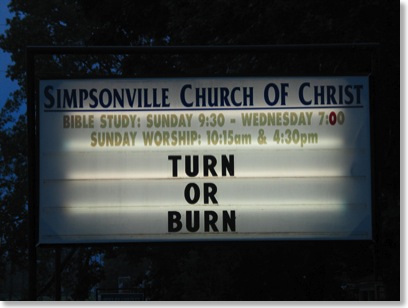
Kathy posted the above picture on her blog in an entry entitled "Tact." No, this is not our church, but it is a church in our community. And this actually is their current sign. We took the picture Friday evening.
Their signs usually tend to lean toward disapproving admonitions. A recent sign they ran quoted Psalm 34:13 in the King James Version: “Keep thy tongue from evil, and thy lips from speaking guile.” While that's certainly good advice from Scripture, it's out of the context of the whole psalm--a wisdom psalm--that also includes the hopeful invitation in v. 8 to "Taste and see that the Lord is good. How happy is the man who takes refuge in Him!" Why would they pick v. 13 for the sign over v. 8?
While there is truth in the statement "Turn or Burn," by itself, it lacks the biblical context of the God who loved the world enough to send his only Son (John 3:16). "Turn or Burn" isn't just the gospel dumbed down; it's the gospel deficient. Repentance (turning) alone, while important, isn't enough to save. Faith in Jesus Christ saves.
I often wonder what non-Christians think when they see such signs. I mean, does anyone read that and say, "By golly--they're right! I've got to turn my life around right now so I don't go to hell! And while I'm at it, I think I'll go to this church next Sunday!" Maybe, but somehow I doubt it. I'm just not sure how effective "church sign" evangelism really is. And my hunch is that a sign such as the one above tends to push people away more than draw them closer to the Savior.
Across the street from the church sign above is another church where they use their marquee to announce the title and/or subject of the upcoming Sunday sermon. And a block or so further down the road is my church where we use our signs to announce our schedule and upcoming events. Surely these are better uses of church signs.
A Spiritual Gift of Contrarianism
"I bet they don't fully appreciate such talent in your meetings," I responded with slight sarcasm.
With mock protest she replied, "It's like a gift of discernment, I think."
"More likely, a gift of contrarianism" I said smiling.
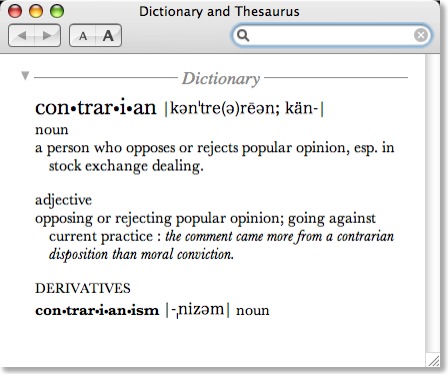
Follow-Up to the Message: What Is the Proper Use of a Bible Paraphrase?
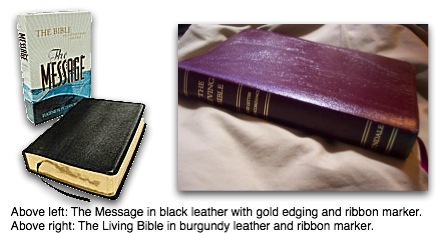
A month ago, I wrote a blog entry entitled, "Is a Paraphrase in the Eye of the Beholder?" that wrestled with the sticky issue of defining a paraphrase in distinction to an actual translation of the Bible. In that entry, I referenced David Dewey's definition of a paraphrase from his book A User's Guide to Bible Translations, but found that his definition wasn't as all-encompasing as what I would like. Dewey paid This Lamp a visit and posted some very helpful insights in the comments section:
The line between paraphrase and a free translation is hard to define and is really quite subjective. But there is a spectrum going from literal through free to paraphrase though different people would place the 'borders' in differing places. I would add that paraphrases are less consistent in their rendering than free translations. I remember talking to Barclay Newman, chief translator of the CEV, who says translation is all about rules, rules and more rules. The CEV and GNB are less paraphrastic than the LB or the Message because the former, though very free, do follow certain rules more consistently whereas the latter are more idiosyncratic.
I feel Dewey's comments are extremely helpful here by generally stating that a translation is bound more by rules of translation while a paraphrase is tends to be more what he calls idiosyncratic. Perhaps we say that a paraphraser has more freedom in his or her renderings.
The Question of Use in Worship. A question that has come out of the comments section from my entry on The Message relates to the proper use of a paraphrase. Jeremy Pierce was surprised that I have used the Message for "public reading" in place of a more traditional Bible translation. Further, Peterson himself seems to discourage such a practice, according to Jeremy, because he doesn't want his work confused with the Bible itself. In a 2002 Christianity Today Interview, Peterson said,
When I'm in a congregation where somebody uses it [the Message] in the Scripture reading, it makes me a little uneasy. I would never recommend it be used as saying, "Hear the Word of God from The Message." But it surprises me how many do. You can't tell people they can't do it. But I guess I'm a traditionalist, and I like to hear those more formal languages in the pulpit.
I suppose that part of Peterson's sentiment comes from his own genuine humility. It's understandable that he would be uneasy about having his rendering of the Bible proclaimed as God's Word. Up until recently, most Bible translators remained anonymous and I can see why. It's a weighty responsibility to even teach or preach God's Word, let alone translate it for the use of others.
Is a Paraphrase of the Bible a Bible? But let's back up to another question. Can a paraphrase of the Bible fairly be called a Bible at all--or is it merely a kind of commentary? I know that some people say absolutely not regarding the question of whether a paraphrase is a Bible. But what about the publishers themselves? There are three major modern paraphrases of the Bible in modern English: J. B. Phillips' New Testament in Modern English (revised 1972), Kenneth Taylor's The Living Bible (completed 1971), and Eugene Peterson's The Message (completed 1992). Of these three, only The Message is in widespread use today.
Early editions of Philips NT and The Message came without verse numbers that seemed an attempt to distinguish them somewhat from being thought of as actual Bibles. But later, publishers included verse numbers in both. I don't think The Message had verse numbers until the Remix edition of 2004, but the numberings had already existed for a few years prior for use in Bible software programs. The Living Bible had chapter and verse designations from the very beginning.
Further, the pictures at the top of this entry depicting leather-bound copies of The Message and The Living Bible were selected with s particular motive. When a publisher begins marketing a Bible paraphrase with leather, gold edges, and ribbon markers, it can only mean one thing: these editions are intended to serve as personal Bibles, possibly even primary Bibles. To me, the message (no pun intended) is unmistakable.
To answer my own question, I would say that yes, I consider a paraphrase of the Bible to be a "real" Bible (but I'll qualify that statement in a moment). When I designated a title for my series on my favorite Bibles, I specifically used "Versions" because I believe a Bible version encompasses both translations and paraphrases. Even the Septuagint seems paraphrased in a few places, and no one would doubt it's place as an ancient text representing God's Word. And "representing" is the key thought here. No version of the BIble--translation or paraphrase is God's Word itself. They are merely a vehicles for communicating God's Word.
And here's the qualifier to my "yes" in the above paragraph. As I have stated before, although I would encourage the use of a paraphrase like The Message, I would never recommend it as a primary Bible for study, but rather as a tool alongside an actual translation. However, some do use paraphrases as their primary Bible. A whole generation of church-goers carried those green hardback Living Bibles every Sunday, and I know of a few older members at my church who still do. I regularly see young people carrying copies of the Message to church.
I certainly understand why people do this. Often paraphrases communicate to these readers in a way that they perceive they understand God's Word better than with actual translations. I don't think it's wise to berate people for the Bible they're using. Surely it's better for someone to read a paraphrase of the Bible than no version of the Bible at all. But it's also important to let people know the benefits and cautions of a paraphrase.
The Benefits and Cautions of Using a Paraphrase. The benefits are clear. Paraphrases communicate God's Word in a very easygoing, contemporary style that may enhance understanding of the Bible. Often, it's easier to get someone who's never read the Bible to read a paraphrase first before picking up an actual translation. Sometimes children respond better to a paraphrase (although I like the Good News Bible best for children) than an actual translation. My experience reflected this when as a child often I couldn't understand a passage in the King James Version, but was able to cross-read it in the Children's Living Bible given to me by my grandmother. Teenagers might respond well to a paraphrase, too. When I used to teach high school Bible, I often used The Message for our reading of longer OT passages (but I did not allow them to use The Message as their Bible for classwork). Further, I thoroughly enjoyed reading through the Message in my devotions a few years back, and recommend it to anyone for that use. It took me longer to get through The Message than any previously read version of the Bible because I slowed down to "hear" the words and I tended to reflect on them more.
But there are also cautions. There's no such thing as a committee-based Bible paraphrase to my knowledge. Therefore, any Bible paraphrase is the product of one individual (such as Phillips, Taylor, or Peterson). As godly and as genuine as these men are, they're still human and can make mistakes. The benefit of a committee-based translation lies in the checks and balances of many eyes upon the work. Further, while all translations of the Bible include some amount of interpretation, paraphrases--which by nature have very free renderings--are simply the most interpretive of any kind of Bible version. Since the paraphrase is the work of one individual, that means one mind is interpreting the text for the reader. As masterful as I believe The Message speaks in contemporary language or as clever as I think Phillips NT renders the text at times, I never let myself forget that I'm receiving one perspective on the biblical message.
I've also seen scripture memory cards that use The Message. Although I believe many parts of The Message are quotable and certainly memorable, I personally would caution someone against using The Message strictly as their only choice for memorization. A downside to any version of the Bible that overly depends on contemporary language remains in the reality that the language will not always be contemporary. To me, paraphrases tend to feel dated more quickly than other versions of the Bible.
That brings us back to the question regarding The Message's use in worship. Although I would use it in worship, I wouldn't do it regularly in place of other translations. Further, I believe it's important to let a congregation know when a paraphrase like The Message is being used rather than letting them wonder why "their Bible" doesn't sound like the reader's.
And for the person who still doesn't want to give up use of The Message as a primary Bible, I would recommend at least using one of Zondervan's parallel editions with the NIV, TNIV or NASB.
What are your thoughts? Feel free to share them in the comments.
The Pirates Strike Back

Lucas can say all he wants about envisioning six or nine movies in his saga, but he probably thought he’d never get past Star Wars. But when he did, Lucas felt like he had to make a more “serious” film, and a “darker” one. The article argues that much of his research for Apocalypse factored into the themes of The Empire Strikes Back: fathers and sons, finding your true nature, and so on.
Apparently the same approach is used in Pirates of the Caribbean: Dead Man’s Chest (hereafter referred to as Pirates, because it’s too long to keep typing). The first Pirates has its share of emotion (Barbosa’s soliloquy about his plight is saddening), but it is really just a popcorn movie with lots of action, scares and comedy.
Not this time around. We get some impressive action, including an exciting “Mexican standoff” version of a swordfight, some good scares and some comedy. But we also get serious themes about “What do you truly want?” and “Will you make the right choices at the right time?” It’s not quite sitting through a lecture, but after awhile it drags down the movie. And there is a lot of “dark”—physically and thematically.
Will and Elizabeth (Orlando Bloom and Keira Knightley) have their wedding day ruined when they are arrested by Cutler Beckett (Tom Hollander), a representative of the East India Trading Company, for helping Jack Sparrow (Johnny Depp) escape from the noose. Beckett offers Will a deal: find Jack Sparrow, bring back Jack’s “broken” compass to be set free. Having no choice, Will agrees. Eventually, Elizabeth sets out on to find Will. Meanwhile, Jack is doing everything he can to hide from Davy Jones (Bill Nighy), because Jack owes him a very serious debt. So everybody travels their own paths, just like in Empire. And everybody has to confront some darkness in others and themselves, like in Empire. And the movie ends on a sort-of cliffhanger, with a lot of loose ends, like in Empire. Think of Yoda as a voodoo priestess, and you’ve got the idea.

Remember what I said about dark? Believe it. This has got to be the darkest movie Disney has ever given its logo, and is definitely NOT for children in any way. There are some gruesome images (including a man having his eye plucked out, a beating heart, any sight of Davy Jones and his crew) that probably should have gotten the movie an R. There’s also a lot of sexual innuendo—far more than in the first movie. And, like Empire, the whole movie has an undercurrent of darkness that can get under your skin.
It takes a while to get the story going (they could have probably figured out how to tighten up the first 45 minutes), but it’s unstoppable after that. The action is first rate. The special effects set a new standard, even if they are a bit uneven. The effects people get bonus points for the kraken, though, which looks like what Ray Harryhausen would have done if he had been asked to design the sand pit monster from Return of the Jedi.
The acting is good too. Pirates brings back most of the supporting players, including some real surprises. Bill Nighy, as Jones, is very impressive, given that the look of his character is entirely computer-generated. Depp gives Jack everything he’s got, doing some great physical comedy (it’s fun just to watch Jack run away).

But the serious tones underlying the story began to tear at the Jack character, which eventually dampens the movie. Without giving plot away, the movie wants Jack to stay a comical scoundrel, but also redeem him. Think of the character development of Han Solo without the smirk. But the movie veers on this issue wildly. For all his funniness, Jack does some very selfish, despicable things in this movie. But when we see Jack act upon a possible redemption, we cheer because we love Jack, but his actions are so out of character, especially in the last twenty minutes or so, that the movie almost falls apart.
It will be interesting to see where the movie’s makers go with all this for the third movie (coming next summer). Storywise, they go out with a truly great setup. But a redeemed Han Solo was really not much fun in Return of the Jedi and I’m not sure a redeemed Jack in the third Pirates will be either.
Andrew Wells can be reached at arwell012002@yahoo.com.
Also of interest: Official Disney website for the Pirates trilogy
Confession: Good for the Soul; Bad for the Reputation

Let me be very honest here. Is it just me or does what often passes for accountability in the church leave you feeling squemish as well?
In the past through various church settings, I've been partenered by a third party with a small group other men (usually two to three) with whom I'm supposed to meet regularly and be accountable, especially about our struggles and failures. But such pairings tend to almost always feel artificial to me. Maybe it's my personality, but I'm just not going to open up and spill my guts to someone whom I don't already consider a close friend. And by a close friend, I mean someone whom I've known for years and has a track record of being faithful and when need be, confidential. But even if I was grouped with very close friends with whom I have trust, would it still be necessary to talk about everything? I've heard of men's accountability groups that have the men ask each other about the state of their sex lives with their spouses. Pardon me, but is that anyone else's business besides the husband and wife in question?
I remember another setting a few years back in which a friend confided something to me from his past. He said he needed an accountability partner. On the surface, that would be fine, but there was no immediate context for his confession. This was something in his past that he had dealt with. It wasn't a current struggle. It wasn't something I really needed to know. So why did he tell me? Well, I was slow at the time, but later I realized that he made this confession, not because he wanted my help, but because he thought I was engaged in some kind of equivalent sin (which I was not--he had misread some circumstances he observed without asking me about it). He assumed that by "opening up" to me about his struggles, I would just naturally confess my sin to him. Of course, I couldn't confess what he wanted me to, simply because it wasn't true. But the artificiality of the whole "meeting for accountabilty" made me feel compelled to confess something. So I told some "lesser" sin from my past which wasn't all that damaging, but later I just felt stupid over the whole situation. And I've never bothered to correct my friend's suspicions about me. I guess he can think what he wants.
That doesn't mean that I'm not open to talking with people about serious problems and acting in a helping and supportive capacity. There's also a very needed role that something like a support group can play in times of crisis or struggle; and in those situations, the lack of personal history with others in the group can be of benefit. And it's one thing if I'm in a pastoral or counseling type role. I've been on church staffs, I've been a chaplain, and I'm often a listening ear for those in need. I can take that position seriously and try to help someone get past his or her sin or time of crisis. And I don't mind opening up to someone else when I have a problem if that person is someone with whom a certain amount of trust has been established. But I just don't get anything out of the "You tell me your sin and I'll tell you mine" mentality that often passes for accountability groups.
We all remember that Jimmy Carter said that he had "lusted in his heart" after other women. Well, we've all done that, but do we need our president making himself accountable to the whole nation over something that personal? (Maybe, in hindsight, another president should have made himself more accountable on this type of issue.) But regardless, no one listened to Carter's confession with a sense of deep concern. We raised our eyebrows and many chuckled within themselves. Carter's statement became the butt of jokes on late night television. I feel like we need discretion regarding what we confess to others, especially in a public forum.
Confession: good for the soul, but bad for the reputation.
Regarding the article Matt linked to... I too cringe at the idea of having someone put $10 in a jar because he or she sinned again in a particular area. Forget that--it screams of legalism; plus, who has enough money? I'm glad the writer of the article (I don't even feel comfortable mentioning his name in light of what's coming) has a group to which he can admit lusting after another woman right before his wife gave birth to their most recent child. But he didn't just confess it just to them (and his wife); he had to go and tell all of us as well. I don't know him--but I don't need or want to know such private things about him. He's shared this with the world--and his church. If I ever meet him--which I doubt I will--I might be thinking about his confession. And I know that pastors are supposed to have a certain level of transparency to relate to people, but is it good for him to tell his whole congregation (which he did by writing the article) that he was lusting after another woman as his wife was about to give birth? I want to take him aside and say, "Hey, buddy--keep that to yourself."
None of us can throw stones when it comes to sin. I realize that. But is it a good idea to be so open about our sin?
Somehow there just seems to be a lack of discretion and a lack of prudence in our motivation to confess stuff to each other these days. I have no doubt that the medieval church's confessional was quite therapeutic for a lot of folks. Go in and talk to a person who can't look you in the eyes and get all the nasty stuff you did off your chest and get offered some kind of penance for it. Done! Past is past--bygones. Yes, I know that confession was abused, but it probably started with good intentions and purer motives. And no doubt, Protestants and the modern world at large have replaced the confessor-priest with the psychiatrist or counselor, probably not always for the better. But "Average Joe" in my church is neither priest nor professional counselor, and I don't feel compelled to have to tell him on a regular basis where I messed up in the last few days.
I realize that James 5:16 says "Therefore, confess your sins to one another and pray for one another, so that you may be healed" (HCSB). However, I don't care for what I perceive as artificiality in the requirement for regular meetings of accountability which usually revert to, "Well, tell me your sins from the past week and then I'll tell you mine." No, I don't think so. And then you know what happens. Your name is mentioned in the next prayer group that your accountability partner attends. "We need to pray for Rick. I can't tell you why, but we really need to pray for him." And then someone concerned pulls him aside later and asks "What's going on with Rick?" The response is then, "Well I really shouldn't tell you this, but... ." Forget it.
Don't think I'm an island. Besides my wife Kathy, who is my best friend, I do have a few of close friends with whom I could confide just about anything--and have--in the case of a major struggle. In fact, I meet with them on a regular basis, but not with an agenda to confess our sins (though sometimes we do). We meet because we are friends and brothers in Christ and we talk about everything--the public, private, spiritual, and earthly. But our ability to confide in each other comes from years of friendship and trust.
When it comes to confession, in addition to James 5:16, I also want to take 1 John 1:9 seriously--"If we confess our sins, He is faithful and righteous to forgive us our sins and to cleanse us from all unrighteousness" (HCSB). But that confession remains between me and God. And for the large majority of what I need to confess, that's where it will stay.
Eugene Peterson's The Message (Top Ten Bible Versions, #5)
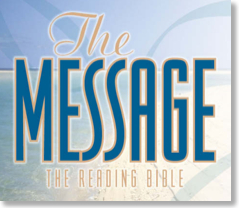
The Message is a paraphrase, not a translation of the Bible. What do I mean by paraphrase? Well, Peterson didn't try to do a word for word translation. Rather, he attempted to put the Scriptures in his own words with a flair for contemporary language. And, in my opinion, he did a very good job. The Message is most easily compared with with Kenneth Taylor's original Living Bible published in the early 1970's. That was a paraphrase, too, but this is so much better. When Taylor paraphrased the Bible, he didn't know the original languages. He took the 1901 American Standard Version and simply put it into his own words. What makes The Message different is that Peterson knows his biblical languages. He sat down with the Greek and Hebrew and created a paraphrase that is masterful in style and form. Truly comparable only to J. B. Phillips' own British paraphrase a few decades ago, Peterson's version is clever, stylistic and begs to be read aloud. I took a longer time reading through The Message than any previous version of the Bible I've read through. I think it's because I got caught up in the wording. I became more reflective, and found myself reading and rereading passages, comparing it to more traditional translations. I would call out to Kathy and say, "Listen to this" and read it to her.
I never recommend a paraphrase to be used as a sole Bible for study. I personally use a number of current Bible translations referenced against the Greek New Testament when I do serious study of the Bible. However, think of a paraphrase such as The Message as an aid, a Bible tool for insight into the meaning of the text. The obvious danger with a paraphrase is that as a person attempts to put the Bible into his or her own words, too much emphasis may be placed on personal interpretation. And, Like Taylor's and Phillips' previous works, paraphrases tend to be done by one person. In fact, I can't recollect any committee-based paraphrases of the Bible, but that's probably a positive in light of its use. The value of a true Bible translation lies in the checks and balances of a committee that works together on the final product. I've read some negative critiques of Peterson's work, including some questions about the way a particular verse reads or what seems to be unnecessary insertions into a verse, but I think overall these concerns are minor. I tend to judge any version of the Bible, whether paraphrase, form-driven or meaning-driven by what the translator(s) were attempting to do. The introduction to The Message states that "The idea is to make it readable--to put those ancient words that their users spoke and wrote into words that you speak and write every day." In regard to that, I believe that Peterson accomplished his purpose.
The Message has now been in complete form for a couple of years. However, it was initially released in portions. I picked up the New Testament in either 1993 or 1994. I remember taking it a number of times to an advanced masters level Greek class "Selected Passages from the New Testament" at Southern Seminary. I remember my professor (who will remain nameless) hated it. In particular, he hated Peterson's phrasings in Galatians. That's ironic because it was Peterson's paraphrases of Galatians from the Greek class he taught himself that first gained him notice and led to NavPress asking him to translate the whole Bible. But if my professor hated it, that's okay. Peterson wasn't writing for professors. He was writing for the regular guy on the street. The same way a missionary might translate the Bible to fit a foreign culture, Peterson seemed to be translating to reach the average American person at the turn of the 21st Century. The Message is one of the few translations that I've ever bought in portions. Usually, I wait until an entire Bible is completed before I pick one up, but Peterson's masterful paraphrase captivated me from the very beginning.
The Message is better experienced than explained. But here's a brief sample of selected passages from The Message itself:
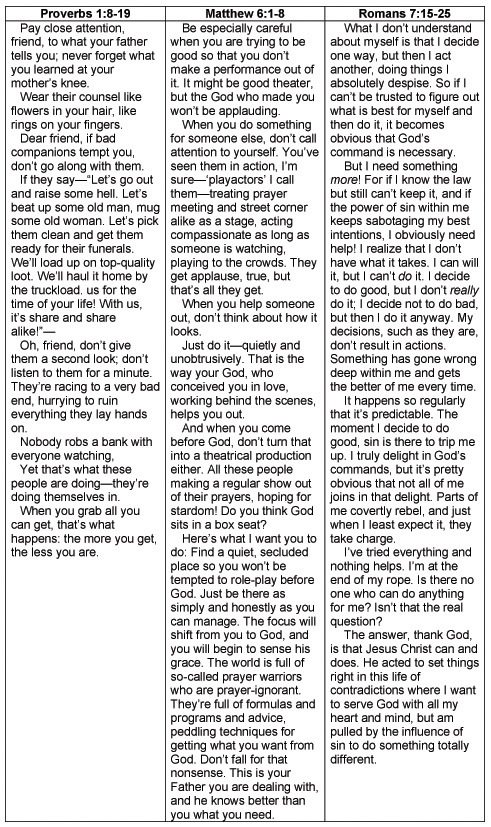
I will admit that my favorite part of The Message is Peterson's rendering of the Bible's wisdom literature. He has a magnificent way of bringing Scripture's wisdom texts into modern contexts. Consider Prov 30:15-16...
A leech has twin daughters
named “Gimme” and “Gimme more.”
Three things are never satisfied,
no, there are four that never say, “That’s enough, thank you!”—
hell,
a barren womb,
a parched land,
a forest fire.”
In some of the earlier editions of the stand-alone OT portions, Peterson used Yahweh for God's divine name. I wish he had stayed with this, but opted to use GOD (in all caps) for the name of God in the final edition. I realize that use of the divine name can be offensive to those in Jewish contexts, but I would suggest that Yahweh could be used in the text and Lord could be read in its place in public readings. I would suggest this for any Bible version as certain passages only make sense if the emphasis is on God's actual name.
Curious as to where Peterson got his title? I figured this out simply by reading through it. The word Message (with a capital M) is used roughly 600 times in Peterson's paraphrase as signifying any divine communication from God. It is used in place of standard renderings such as "Thus spoke the Lord," "vision," "the word of God," etc.
The Message is certainly not perfect, and perhaps a paraphrase makes an easier target than most Bible versions for criticisms. I sometimes found myself wondering how this or that rendering could be justified with even the most extreme meaning-driven approach. But a paraphrase gives one extra freedom. I have also written in the past regarding The Message's deficient rendering of texts relating to homosexuality. I will include a link at the end of this entry.
Recently, as a tool for use with The Message, Peterson has released The Message Three-Way Concordance: Word/Phrase/Synonym.
How I use the Message. I've used The Message on and off for ten years now, usually either for devotional purposes or for public readings. I read selected passages from 2 Timothy when I gave my friend, Jason Snyder, his ordination charge. I've used it occasionally in my Bible study class on Sunday mornings to allow participants to hear familiar passages with "a different ear." I used it frequently with my students when I taught high school-level Bible courses at Whitefield Academy, especially when assigning longer passages of the Bible. When I read a passage from The Message (in a loud and clear voice with lots of drama and annunciation), they soon figured out it was too difficult to follow along in their translations. So they put them down and looked up to watch me. As I looked at their faces, these teenagers seemed to transform into little children listening to Bible stories. Most recently, I've used The Message for a Scripture reading in our worship service at church. The Message is also a good choice to use when speaking to a crowd that may be largely unfamiliar with the Bible, and it is certainly a good choice to give to someone who wants to read the Bible for the first time. I also noticed when we were in Louisiana last week that my mother-in-law is systematically reading through The Message.
What editions of the Message I Use. When the entire Bible was released in 2002, I gave away my portions to a friend and bought a hardback copy of the complete Bible. That's what I used for a couple of years (in addition to a software copy of the text that I have in Accordance).
More recently, I decided to get one of the newer editions that was not only in leather (I think it's leather), but also with verse numbering which was absent from all initial editions. That's how I came across The Message//Remix. It comes in both a hardback printed cover edition and a funky blue alligator bonded leather edition. I have the funky blue one.
How is The Message//Remix different from previous editions? Well, it fixed the one thing that frustrated folks who regularly use The Message--they added verse numbers! Yes, I understand why the original edition (which is still being published) does not have verse numbers. The biblical writers did not include chapter and number divisions in the original works. We have added these to make referencing particular passages easier. Peterson wanted people not to get bogged down the by unnatural interruption caused by verse references. He wanted us to read it as it was meant to be read in one continuous train of thought. Yet, it was often frustrating not to have the references included, especially when using The Message in conjunction with other translations. But the little known secret is that verse numbers have existed for a while in software editions where they are absolutely necessary. In this new edition, the publisher compromised and took a cue from the New English Bible and put the verse references out in the margins rather than interrupting the text with them.
Like the original edition, The Message//Remix keeps a one-column format which I prefer in a Bible. The paper used in this edition is a pleasing off-white. Book introductions have been revised from the original ones written by Peterson. They tend to be a bit shorter, but still just as powerful. I still like how Peterson introduces Ecclesiastes: "Unlike the animals, who seem quite content to simply be themselves, we humans are always looking for ways to be more than or other than what we find ourselves to be. We explore the countryside for excitement, search our souls for meaning, shop the world for pleasure. We try this. Then we try that. The usual fields of endeavor are money, sex, power, adventure, and knowledge."
The Introduction has new information as well, or at least a new layout--a remix--of the information about the paraphrase found in the original edition. But it's in a a more reader-friendly format. There is a section called "Listening to the Remix" that asks the question, "Why does a two thousand-year-old book still matter?" This part of the introduction seeks to distinguish the Bible from other literature such as Romeo and Juliet, Uncle Tom's Cabin, and Catcher in the Rye. There is a section that asks "Who is Eugene Peterson? Most Bibles don't have a person's name on them. So who is Eugene Peterson and why does he get his name on the front page of this particular Bible?" The best part of the introduction, in my opinion though lies in an essay called "Read. Think. Pray. Live" which truly describes how the Christian should incorporate God's Word into his or her life. I've seen the essay starting to show up a few other places outside this Bible lately, too. I don't know where it appeared first--here or somewhere else.
Finally--and some of you may find this silly--this Bible feels good in the hand. This is very subjective, and I don't know if you will even get what I'm saying. I'm just eyeballing here, but it measures about 7 1/2" X 5" and 1 1/2" thick. That's really one of my favorite sizes for a book. If you look at a library shelf of books from fifty years ago or more, lots of books were this size--hand size, I call it. It fits in your hand well. The cover is limp so it hangs (at the least the leather edition) like a Bible is supposed to.
For Further Reading:
- The Message Web Page (Navpress)
- History and FAQs (NavPress)
- The Message Wikipedia Entry
- Bible Researcher Page on The Message
- Better Bibles Blog Page on The Message (extensive discussion in the comments)
- Is the Message Soft on Homosexuality? (R. Mansfield)
- Follow-Up to the Message: What is the Proper Use of a Bible Translation? (R. Mansfield--added 7/13/2006)
Next entry: The Revised English Bible
Superman: The Iconic Review

A great deal of this mythos, as Rick said in his review, has been shaped by the Superman movies--especially the first one. Superman: The Movie is flawed in different ways--some outdated special effects, inconsistencies in the plot, goofy humor, etc.—but director Richard Donner, composer John Williams and Christopher Reeve got the epic and joyful tone right; they knocked that one right out of the park. When Superman flies by us in that last scene, it’s as deeply felt a movie moment as any in history: the most powerful being on earth, and he slows down to stop and smile at us. It’s pure joy and bliss, epic and wonderful, and Donner let us relish that moment
For all the lavish and respectful devotion paid to everything Superman, Superman Returns just doesn’t get that. The opening credits and the final scene will tell you why.
Instead of letting us soar with Williams' theme and feel the vastness of space, director Bryan Singer fills the screen with images as we swoop by various wonders of the galaxy. The movie is too busy trying to keep us interested. The whole movie is like this, with few exceptions.
I’d like to say more, but I’m not sure I really need to. The final scene says it all.
In homage to the Superman movies, we see Superman (Brandon Routh) flying over the curve of the earth, right past us.
But he’s gone too quickly, and he doesn’t stop to smile.
Andrew Wells can be reached at arwell012002@yahoo.com
Bible Bias: An Observed Double-Standard
I eventually made my way over to the Bibles. Pretty standard stuff--they had lots of copies of the NIV, KJV, NLT, NASB, HCSB, the Message, a few ESVs, and a small representation of the NAB. One recent translation I noticed absent from the shelves was the Today's New International Version. More out of curiosity than anything else, I asked the more authoritative-looking person working in the store if they carried any copies of the TNIV. She said they didn't have any in stock, but could order anything I wanted. Of course, I wasn't in the market anyway, already having two copies and inquiring simply out of curiosity, so I thanked her, but said it wasn't necessary.
Then, as if to try to demonstrate some knowledge regarding the TNIV, she added that they had received a few copies of the TNIV, but in "polling" (whatever that meant), the local pastors, the TNIV proved too controversial and was viewed with negative criticism. Therefore, they opted not to carry any copies, but she reminded me that any edition could be special ordered.
I looked again at the shelves and saw stacks and stacks of the original NIV, the NLT and the Message. Exactly what in the TNIV was so controversial? Was it the fact that the TNIV is not a formal-equivalent version of the Bible? If so, neither were the majority of the Bibles on the store's shelves. Was it the use of inclusive language for humans when the context of the audience was both male and female? Then why carry the New Living Translation and the Message, both of which do the same thing? Was it because the NIV is so firmly entrenched that people are resistant to any revision--in spite of the fact, that the TNIV is only 7% different from the NIV, and most of the changes are a vast improvement in terms of translational accuracy? Not to mention the fact that the TNIV is often less dynamic in places than its predecessor.
I knew the answer, of course. It was the second option regarding the firestorm of criticism over the use of gender-inclusive--or gender-accurate (the term preferred by the TNIV translation committee)--language. But this is such a double-standard. The NLT in both the 1996 and 2004 editions have used inclusive language, and it far outsells the TNIV. The CBA sales results for July, 2006, show the NLT as the #4 best-selling Bible version while the TNIV isn't even in the top ten:
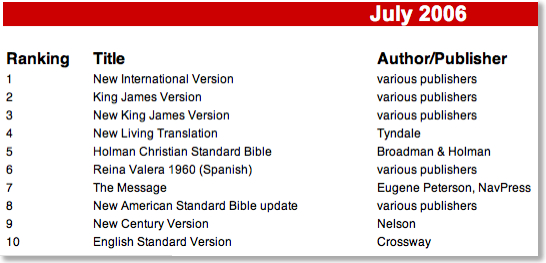
I find it disheartening to see a good translation like the TNIV suffer from a smear-campaign of misinformation even in my hometown. Maybe that's strong sentiment, but I don't know how else to explain why the TNIV would be shunned while the NLT would be embraced, when they both contain the same supposed controversial features. Why would a store not carry the TNIV because of inclusive language, but continue to carry the New Living Translation, the Message, the Good News Bible, the New American Bible, and the New Revised Standard Version? I simply don't understand.
To that effect, I very politely said to the woman running the store that anything controversial in the TNIV is also found in the New Living Translation. She shrugged her shoulders and said, "You're right, but some people can't even let go of the King James Version yet." She's correct, of course, but as we approach the 400th anniversary of the KJV, maybe it's time for us to move on..regarding a lot of things...










